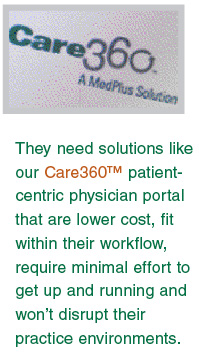A Revolution in Healthcare IT
As our nation looks to reform our healthcare system by improving outcomes and reducing costs, expanding the use of healthcare information technology will be critical.
Many physicians keep patient records, including lab test results, in manila file folders. Slowly but surely, much of that information is going digital. However, it is often being stored in discrete, “closed” computer systems and is not easily shared with other doctors or hospitals. Additionally, over 80% of physicians are in practices with fewer than 10 physicians, and they tend to adopt electronic solutions more slowly. They need solutions like our Care360™ patient-centric physician portal that are lower cost, fit within their workflow, require minimal effort to get up and running and won’t disrupt their practice environments.
Today, more than 140,000 physicians use our Care360 suite of connectivity solutions to order lab tests, prescribe drugs and share clinical information with other healthcare providers quickly and securely. By the end of 2008, the number of drug prescriptions ordered through Care360 more than doubled to an annual rate of 4.5 million.
Because Care360 is interoperable and is used by physicians thousands of times each day, it represents a vital part of the national healthcare information infrastructure. We believe the best approach to spur rapid adoption of electronic medical records must include solutions like Care360.
Our healthcare IT subsidiary, MedPlus®, has particular expertise in providing technology that helps to connect physician practices and other healthcare providers. MedPlus technology is at the heart of the emerging North American digital healthcare infrastructure, and is a key part of public health information exchanges in California, New York, British Columbia and New Mexico. Health information exchanges facilitate the transfer of approved patient information among healthcare providers to improve decision making and outcomes, and reduce costs.
New Markets, New Geographies
Our business is changing and diversifying. As recently as eight years ago, routine testing, which includes complete blood counts and cholesterol tests, accounted for three quarters of our revenues. Today, it is just over half. In contrast, faster growing, higher value, gene-based, esoteric and anatomic pathology testing has increased to 36% of revenues from 19% over that period.
We are expanding into new markets and geographies for longer term growth. Testing is moving closer to the patient. Our point-of-care testing business is growing, and we continue to introduce new products. We launched in the U.S. our HemoCue® CLIA-waived microalbumin point-of-care test, which is used to detect kidney failure. We also introduced in Europe a white blood cell testing platform, which assists in the diagnosis of infection, and are awaiting its CLIA waiver in the U.S.
In Ireland, through a national contract to perform cervical cancer screening, we helped reduce “anxiety time”—the amount of time women have had to wait to receive their Pap test results—from six months to two weeks.
During 2008, we began offering services and products in the growing market in India. We see significant opportunities for us to strengthen the delivery of healthcare services in India utilizing our quality diagnostics and technology expertise.
Patients, Growth, People
Our company is strong and growing. We have a successful strategy with a focus on Patients, Growth and People that continues to provide us with a clear roadmap for the future. Our 43,000 dedicated employees are committed to putting patients first in all that we do. It is because of their hard work that we are well prepared to take on the challenges before us and further differentiate our company.
Thank you for your continued support and confidence.
Take care,

Surya N. Mohapatra, Ph.D.
Chairman, President and Chief Executive Officer



